The following topic has the purpose of providing additional details about the specific and unique attributes of the subtitles in East Asian languages.
The text in the Japanese and Chinese writing systems can be oriented horizontally from left to right or vertically from top to bottom. This, in return, means that subtitles in these languages need to be able to re-create it too:
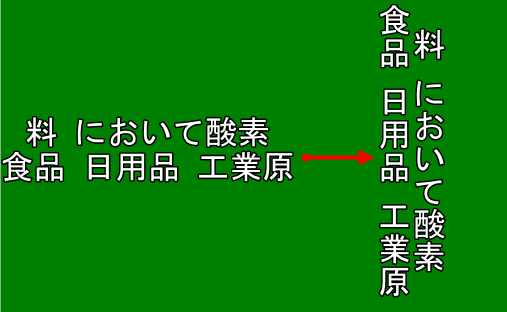
EZConvert supports subtitles with vertical text and also enables the conversion of the display direction from horizontal to vertical by changing the Project Settings, as explained earlier.
Ruby characters, or simply Rubies, are small annotation characters placed above or to the right of East Asian Text usually in Chinese or Japanese. They typically serve the purpose of pronunciation guides for symbols that are likely to be unfamiliar to the reader:

In the above example, the base text stands for "Tokyo" written with kanji and the rubies are in written hiragana, although they could be written in different writing scripts according to the requirements of the particular language.
The image to left, on the other hand, clearly indicates how the text should be pronounced.
Note: Bouten are special type of ruby characters used to emphasize parts of the text. The type of Bouten that will be used can be modified from the Preferences menu prior to importing a file in EZConvert
Ruby Position
Ruby's position is also very important, they can be inserted above or below horizontal text or to the left or right of vertical text. The most commonly accepted practice, however, is to position the Rubies according to the following rules:
Above |
Rubies are displayed above the base text in horizontal subtitles and to the right of the base text in vertical subtitles. |
Below |
Rubies are displayed below the base text in horizontal subtitles and to the left of the base text in vertical subtitles. |
AUTO |
The Auto option complies with the most commonly accepted by companies like Netflix rules: ▪For single line subtitle with horizontal direction – position ruby above character; ▪For single line subtitle with vertical direction – position ruby on right side of character; ▪If ruby is present on the second line of a two-line horizontal subtitle – position ruby below ruby base; ▪If ruby is present on the second line of a two-line vertical subtitle – position ruby on left side of ruby base. |
Ruby and bouten positions set by the "Auto" option are identical to those set by tts:rubyPosition="outside" in Timed Text ver 2 specifications.
However, there's at least one distinct exception of this rule. According to Disney+ specifications and requirements ruby or bouten in one-line vertical subtitle aligned to the left should be displayed to the Left side of the base text. So, when the delivery format is going to be Disney+ Japanese IMSC 1.1 the position for those ruby or bouten characters should be "Left" and not "Outside". Later on, you could always use the integrated Check Subtitles and Fix Subtitles options to automatically locate and resolve any potential positioning conflicts.
Ruby Alignment
Ruby Align (short from alignment) allows you to control ruby's position compared to base text - in the center, spaced around all characters, spaced between all characters, at the start or at the end of base text, as shown on the picture below:
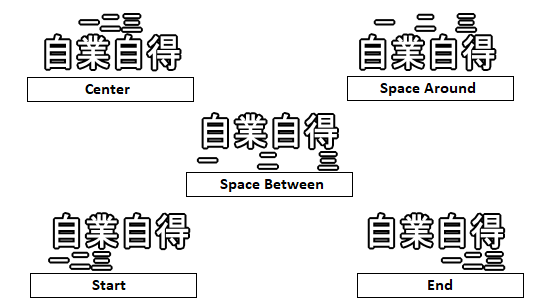
The selected ruby alignment can be exported to:
All positions are supported. |
|
Images for DVD/Blu-ray |
All positions are supported. |
Images for Digital Cinema: |
The two image based exports for Digital Cinema support all positions. |
Supports only center and space around positions. |
|
Currently only center is supported. |
Exporting to a file that doesn't support specific ruby alignment will generate a Warning. You can later use Check Subtitles to find all rubies with specific alignment or Fix Subtitles to change alignment of all rubies in the file.
The Horizontal Group is a group of characters which has to retain its horizontal orientation in otherwise vertical subtitle:
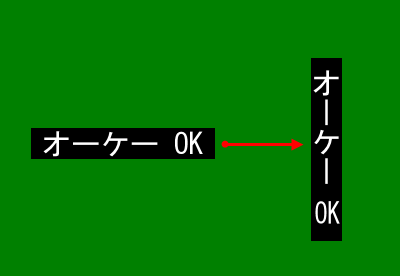
There are certain requirements concerning the orientation for digits appearing among a vertical text. It is widely accepted to display all the digits as a full-width characters vertically oriented in the reading direction:
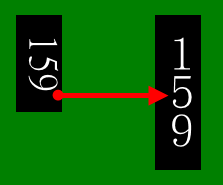
or rather as a horizontal group of half-width digits:
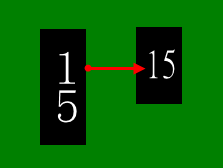
It is possible to change the display orientation of numbers inserted in vertical subtitles by using the respective Fix Subtitles options as well as to check if there any numbers incorrectly displayed by using the Check Subtitles.
In addition it is also possible to change the orientation of all subtitles from horizontal to vertical by modifying the respective Text Direction options from the Project Settings/Presentation menu.
Note: Vertical subtitles and ruby characters will be correctly preserved in the .EZT, .EZTXML, subtitles for Digital Cinema as DLP Subtitle XML or DCDM (SMPTE 428-7-207) XML, Videotron Lambda (.cap), WebVTT (.vtt), TTML v.2 Timed Text, IMSC 1.1 (.dfxp, .xml), Apple iTunes Timed Text (.itt) formats and can be exported as DVD Images or DVB subtitles.